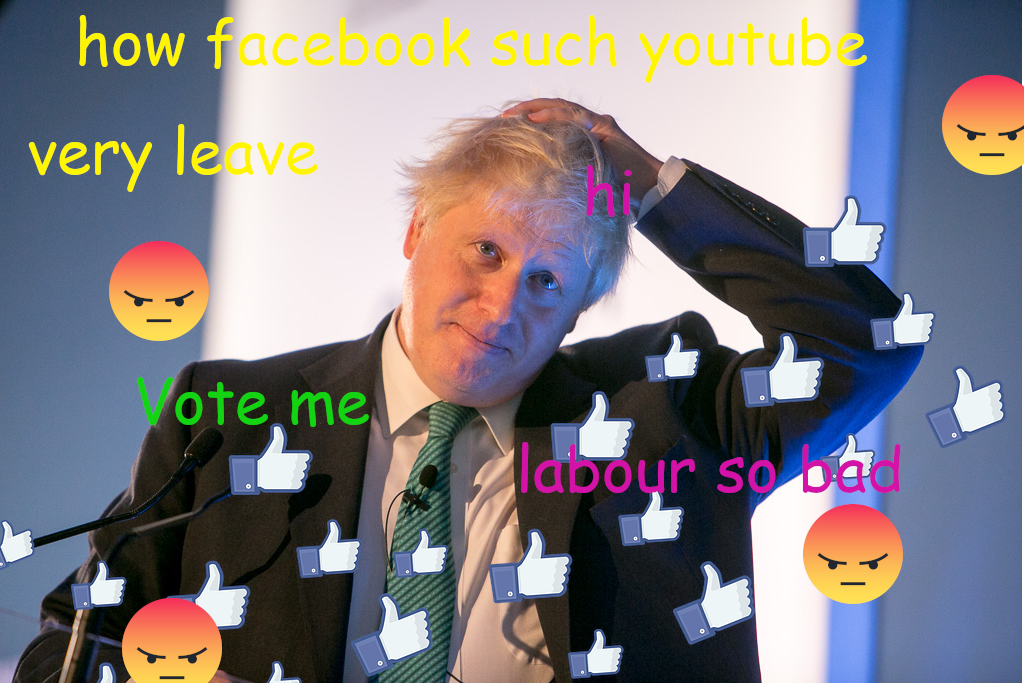Asymmetric Advertising Is the New Fake News, and the Tories May Be Using It to Hijack Your Social Media
by Stuart Mills
11 November 2019

While the general election is just beginning, the battle for social media rumbles on. The power to get one’s message out quickly and widely – including to those often omitted from politics – has been noted by political operatives and is now a vital part of electoral strategy.
The Labour party led the online charge in 2017, utilising social media to energise their grassroots and releasing the viral ‘Our Town’ campaign video. By contrast, the Tory party didn’t seem to grasp the social in social media: while Labour increased their social media following by 61% during the last general election, the Tories went up only 6%.
At party conference, lessons hadn’t been learnt; the Tories posted badly-lit and meaningless photos to their Instagram, while their YouTube channel was treated as a video dump, with most uploads garnering only a few hundred views.
It’s a numbers game.
The Tories have attempted to improve their social media game, but they face a demographic challenge. Worldwide, around 90% of millennials used some social media in 2019, compared to only 48% of Baby Boomers. Factoring in Gen Z, the average social media user is overwhelming on the younger side, and young people generally reject rightwing politics.
And rejection doesn’t have to be objection; on social media, a user can reject a message simply by not following an account. This compounds difficulties: in the 2017 general election, despite outspending all their rivals on social media advertising, the Conservative party’s ads were seen by fewer people than Labour’s because of the massive differential in following. In 2019, this differential remains.
Built to break.
Rightwing politics has a smaller audience to appeal to on social media, and flashier content or greater spending won’t change this. But in response to this numbers game, a strategy which I call asymmetric advertising has emerged.
Asymmetric advertising is content that is designed to hijack a user’s social media feed, to become amplified on the platform. The rise of fake news in 2016 is an example of asymmetric advertising in action, with outlandish or hilarious headlines encouraging political opponents to share that material, if just to point out its absurdity. This served a purpose. A political opponent likely has a smaller crossover following compared to a political ally, and so by hijacking the former’s feed, you get more eyeballs on the content. This is only half the strategy, however. By being amplified, the content is increasingly likely to appear in the feeds of users who are out-of-the-loop and will take it at face value, while the increased scrutiny galvanises the existing base to support the post.
By being built-to-break, asymmetric advertising turns opposition on its head, allowing the message to seep through.
The Tory party has recently been producing content which might be called asymmetric advertising. A now infamous Conservative party tweet written in comic sans spawned a hashtag from popular political commentators mocking it.
Now is the time for MPs to back the new deal and get Brexit done.#GetBrexitDone pic.twitter.com/JuqaOVdlMC
— Conservatives (@Conservatives) October 22, 2019
Another example includes an edited video, also posted by the official Conservative party Twitter account, showing Labour’s Kier Starmer seemingly unable to answer a question about Brexit.
WATCH: Jeremy Corbyn’s Brexit Minister can’t or won’t answer a simple question about Labour’s position on Brexit. pic.twitter.com/wsxMlUuq9N
— Conservatives (@Conservatives) November 5, 2019
This video had a noticeable impact. Within 11 hours, the clip had been viewed 580,000 times, compared to a similar video of a Conservative MP talking on a popular Sunday morning program which only received 48,000 views in an overlapping 15-hour window. While the attacking nature of the Starmer clip may explain some of this difference, most of these views should be chalked up to the fake news controversy it generated.
This isn’t shitposting.
Asymmetric advertising is a contentious idea because it assumes intention, which is difficult to prove. The comic sans tweet might be 4D chess, or it might just be bad digital strategy. The Starmer clip might be engineered fake news or, as Tory party chairman James Cleverly argues, it might just have been edited to fit the constraints of social media. These excuses make asymmetric advertising more subversive: built-to-break posts can always be rationalised as just badly-built.
Yet, asymmetric advertising is the logical explanation behind the Tory’s erratic social media posts. As an anonymous staffer told the Sydney Morning Herald, two Tory campaign strategists engaged in a strategy of, “boomer memes,” and, “[making] really basic and deliberately lame [posts] because they’d get shares,” as part of their recent work in the Australian election. Similarly, the BBC’s Laura Kuenssberg recently described asymmetric advertising techniques in talking about the Tories social media strategy – though mislabelled the strategy shitposting.
But this isn’t shitposting. Asymmetric advertising propagates misinformation, controversy and distraction to hijack social media. It intentionally tries to skew attention on to the form, while the substance remains unchallenged and spreads.
Pack it in.#ComicSans Comic Sans pic.twitter.com/UvUZIEvQVa
— Rob Birnie (@Mr_Rob_Birnie) October 22, 2019
And it continues to fight back; even by explaining asymmetric advertising, the examples used get amplified. But ignoring asymmetric content isn’t an option either. Only by learning to identify asymmetric adverts, and using strategies such as subtweeting to avoid amplifying them, can the power of asymmetric advertising be brought under control.
Stuart Mills is a PhD Researcher at the Future Economies Research Centre specialising in behavioural science, data politics and digital economy.